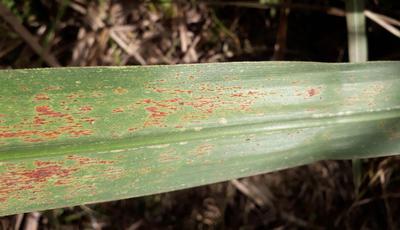Orange Rust of Sugarcane
Puccinia kuehnii
Kuvu
Kwa Ufupi
- Orange to orange-brown lesions on the plant.
- Appearance of spores on the leaf sheath and lower side of the leaves.
Inaweza pia kupatikana kwenye
Dalili
Lesions begin as small dead spots on the leaf. They later develop into orange-brown lesions which are up to 4 mm long and 3 mm wide. The lesions are usually concentrated towards the leaf base and occur in groups. Orange spores are produced on the lower side of leaves. Severely-affected leaf tissue dies, which leads to a reduction of the crop canopy. In severe cases, the spots also appear on the leaf sheath, resulting in the entire foliage appearing brown from a distance.
Mapendekezo

Udhibiti wa Kiasili
To this day, we are not aware of any biological control method available against this disease. If you know of any successful method to reduce the incidence or the gravity of the symptoms, please contact us.

Udhibiti wa Kemikali
Always consider an integrated approach with preventive measures together with biological treatments, if available. Fungicides can reduce yield losses. Spray plants with Strobilurin class fungicides such as pyraclostrobin and azoxystrobin, which can be used to treat the disease. Also, triazole class fungicides such as metconazole and propiconazole can be applied at 3 to 4-week intervals.
Ni nini kilisababisha?
The disease is caused by the fungus of Puccinia kuehnii. It is spread by rust that produces spores that are microscopic, light and hardy, which makes it easy for rapid short- and long-distance dispersal by wind and water splash. The spores also survive in plant residues in the soil. The disease is usually observed in summer and early autumn with warm, wet and highly humid environmental conditions. It infects more mature cane (usually more than 6 months in age). The growth and spread are limited by temperatures exceeding 30°C and also humidity between 70 and 90%. High wind velocity and continuous cloudiness further aggravate the disease.
Hatua za Kuzuia
- Plant resistant varieties.
- Practice good sanitation of the field or orchard by removing plant debris, for example.
- Regularly monitor fields or orchards for signs of the disease.



